
Illustrative Math Alignment: Grade 8 Unit 3
Functions and Volume
Lesson 13: The Volume of a Cylinder
Use the following Media4Math resources with this Illustrative Math lesson.
| Thumbnail Image | Title | Body | Curriculum Topic |
|---|---|---|---|
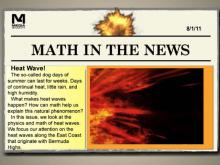
|
Math in the News: Issue 20--Heat Wave! | Math in the News: Issue 20--Heat Wave!
8/1/11. In this issue we look at the physics of air pressure and the forces that give rise to heat waves. This is part of the Math in the News collection. To see the complete collection, click on this link. Note: The download is a PPT file.Related ResourcesTo see resources related to this topic click on the Related Resources tab above. |
Data Analysis |
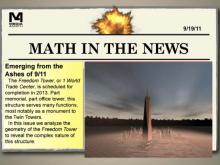
|
Math in the News: Issue 27--Emerging from the Ashes of 9/11 | Math in the News: Issue 27--Emerging from the Ashes of 9/11
9/19/11. To commemorate the 10-year anniversary of the 911, we look at the geometry and architecture of the Freedom Tower, currently under construction. This is part of the Math in the News collection. To see the complete collection, click on this link. Note: The download is a PPT file.Related ResourcesTo see resources related to this topic click on the Related Resources tab above. |
3-Dimensional Figures |
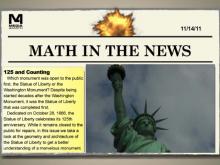
|
Math in the News: Issue 35--125 and Counting | Math in the News: Issue 35--125 and Counting
11/14/11. In this issue we commemorate the 125th anniversary of the Statue of Liberty. We also look at the geometry and architecture of this monument. This is part of the Math in the News collection. To see the complete collection, click on this link. Note: The download is a PPT file.Related ResourcesTo see resources related to this topic click on the Related Resources tab above. |
Surface Area and Volume |
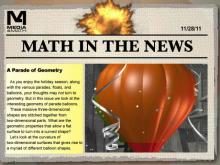
|
Math in the News: Issue 37--A Parade of Geometry | Math in the News: Issue 37--A Parade of Geometry
11/28/11. In this issue we look at the geometry of parade balloons. This is part of the Math in the News collection. To see the complete collection, click on this link. Note: The download is a PPT file.Related ResourcesTo see resources related to this topic click on the Related Resources tab above. |
Surface Area and Volume |

|
Math in the News: Issue 38--December 7, 1941 | Math in the News: Issue 38--December 7, 1941
12/7/11. In this issue we look at the heroic work of salvaging and retrofitting many of the ships sunk during the attack on Pearl Harbor. This is part of the Math in the News collection. To see the complete collection, click on this link. Note: The download is a PPT file.Related ResourcesTo see resources related to this topic click on the Related Resources tab above. |
Surface Area and Volume |
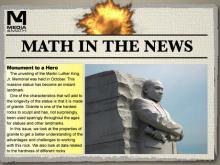
|
Math in the News: Issue 39--Monument to a Hero | Math in the News: Issue 39--Monument to a Hero
12/12/11. In this issue we look at the MLK Memorial and the special properties of granite that presented some design challenges in the construction of the statue. This is part of the Math in the News collection. To see the complete collection, click on this link. Note: The download is a PPT file.Related ResourcesTo see resources related to this topic click on the Related Resources tab above. |
Surface Area and Volume |
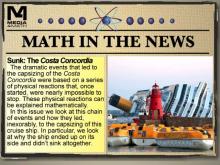
|
Math in the News: Issue 44--Sunk: The Costa Concordia | Math in the News: Issue 44--Sunk: The Costa Concordia
January 2012. In this issue of Math in the News we analyze how the Costa Concordia sank. This is part of the Math in the News collection. To see the complete collection, click on this link. Note: The download is a PPT file.Related ResourcesTo see resources related to this topic click on the Related Resources tab above. |
Surface Area and Volume |
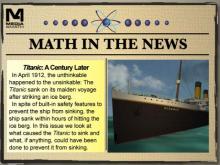
|
Math in the News: Issue 53--Titanic: A Century Later | Math in the News: Issue 53--Titanic: A Century Later
April 2012. In this issue of Math in the News we analyze the sinking of the Titanic. It has been a hundred years, yet the story of the sinkin g of the Titanic still fascinates. This is part of the Math in the News collection. To see the complete collection, click on this link. Note: The download is a PPT file.Related ResourcesTo see resources related to this topic click on the Related Resources tab above. |
Surface Area and Volume |

|
Math in the News: Issue 56--The Freedom Tower | Math in the News: Issue 56--The Freedom Tower
May 2012. In this issue of Math in the News we look at the architecture of the Freedom Tower, now that it has become the tallest building in NYC. This is part of the Math in the News collection. To see the complete collection, click on this link. Note: The download is a PPT file.Related ResourcesTo see resources related to this topic click on the Related Resources tab above. |
3-Dimensional Figures |

|
Math in the News: Issue 73--County Fairs and Funnel Cakes | Math in the News: Issue 73--County Fairs and Funnel Cakes
August 2013. In this issue we look at the geometry of funnel cakes. You'll like the sweet results. This is part of the Math in the News collection. To see the complete collection, click on this link. Note: The download is a PPT file.Related ResourcesTo see resources related to this topic click on the Related Resources tab above. |
Surface Area and Volume |

|
Math in the News: Issue 8--Tornado Damage | Math in the News: Issue 8--Tornado Damage
5/9/11. In this issue we look at tornado season. In particular we study why the swirling winds of a tornado are so damaging. This is part of the Math in the News collection. To see the complete collection, click on this link. Note: The download is a PPT file.Related ResourcesTo see resources related to this topic click on the Related Resources tab above. |
Data Analysis |
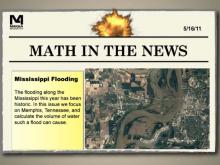
|
Math in the News: Issue 9--Mississippi Floods | Math in the News: Issue 9--Mississippi Floods
5/16/11. In this issue we look at the flooding along the Mississippi. In particular we analyze the flooding along Memphis, Tennessee. We develop a model for predicting the amount of flooding. This is part of the Math in the News collection. To see the complete collection, click on this link. Note: The download is a PPT file.Related ResourcesTo see resources related to this topic click on the Related Resources tab above. |
Volume |
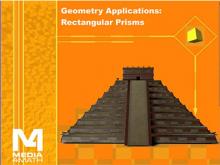
|
Promethean Flipchart: Geometry Applications: 3D Geometry 1 | Rectangular Prisms. Mayan pyramids are essentially stacks of rectangular prisms. The volume of each successive level is a percentage decrease of its lower neighbor. This introduces the notion of a geometric sequence and series, including an infinite series. Note: The download for this resources is the Promethean Flipchart. For access to the full video [Geometry Applications: 3D Geometry, Segment 2: Pyramids]: https://media4math.com/library/geometry-applications-3d-geometry-segment-2-pyramids This video includes a Video Transcript [Video Transcript: Geometry Applications: 3D Geometry, Segment 2: Pyramids]: https://www.media4math.com/library/video-transcript-geometry-applications-3d-geometry-segment-2-pyramids |
Applications of 3D Geometry |
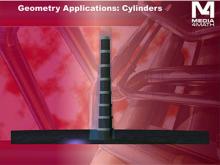
|
Promethean Flipchart: Geometry Applications: 3D Geometry 2 | The Shanghai Tower in China is a stack of cylindrical shapes, where each successive layer is a percentage decrease of its lower neighbor. As with the previous section, this introduces the notion of a geometric sequence and series. Note: The download for this resources is the Promethean Flipchart. To access the full video [Geometry Applications: 3D Geometry, Segment 3: Cylinders]: https://media4math.com/library/geometry-applications-3d-geometry-segment-3-cylinders This video includes a Video Transcript [Video Transcript: Geometry Applications: 3D Geometry, Segment 3: Cylinders]: https://www.media4math.com/library/video-transcript-geometry-applications-3d-geometry-segment-3-cylinders
|
Applications of 3D Geometry |

|
Video Definition 14--3D Geometry--Horizontal Cross-Section of a Cylinder | Horizontal Cross-Section of a CylinderTopic3D Geometry DefinitionA horizontal cross-section of a cylinder is the intersection of the cylinder with a horizontal plane, resulting in a circle. |
Cylinders |

|
Video Definition 14--3D Geometry--Horizontal Cross-Section of a Cylinder--Spanish Audio | Video Definition 14--3D Geometry--Horizontal Cross-Section of a Cylinder--Spanish Audio This is part of a collection of math video definitions related to the topic of 3D Geometry. These videos have Spanish audio. Note: The download is an MP4 video. |
Cylinders |
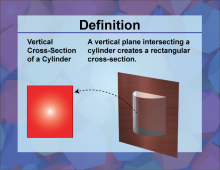
|
Video Definition 56--3D Geometry--Vertical Cross-Sections of a Cylinder | Vertical Cross-Sections of a CylinderTopic3D Geometry DefinitionVertical cross-sections of a cylinder are the intersections of the cylinder with vertical planes, resulting in rectangles or ellipses. |
Cylinders |

|
Video Definition 56--3D Geometry--Vertical Cross-Sections of a Cylinder--Spanish Audio | Video Definition 56--3D Geometry--Vertical Cross-Sections of a Cylinder--Spanish Audio This is part of a collection of math video definitions related to the topic of 3D Geometry. These videos have Spanish audio. Note: The download is an MP4 video. |
Cylinders |

|
Video Definition 9--3D Geometry--Cylinder | Cylinder
Topic3D Geometry DefinitionA cylinder is a three-dimensional geometric shape with two parallel circular bases connected by a curved surface. DescriptionCylinders are common in everyday objects, such as cans and pipes. In mathematics, cylinders are studied for their properties, including surface area and volume. The volume V of a cylinder is given by the formula V = πr2h |
Cylinders |

|
Video Definition 9--3D Geometry--Cylinder--Spanish Audio | Video Definition 9--3D Geometry--Cylinder--Spanish Audio This is part of a collection of math video definitions related to the topic of 3D Geometry. These videos have Spanish audio. Note: The download is an MP4 video. |
Cylinders |

|
Video Transcript: Geometry Applications: 3D Geometry | Video Transcript: Geometry Applications: 3D Geometry
This is the transcript for the video of same title. Video contents: In this program we explore the properties of three-dimensional figures. We do this in the context of two real-world applications. In the first, we look at the three-dimensional structure of Mayan pyramids. These stair-step structures provide a unique opportunity to also explore sequences and series. In the second application we look at the Shanghai Tower as an example of cylindrically shaped structures. |
3-Dimensional Figures and Applications of 3D Geometry |

|
Video Transcript: Geometry Applications: 3D Geometry, Segment 1: Introduction | Video Transcript: Geometry Applications: 3D Geometry, Segment 1: Introduction
This is the transcript for the video of same title. Video contents: We visit ancient Greece to learn about the Platonic Solids. This provides an introduction to the more general topic of three-dimensional figures. This is part of a collection of video transcript from the Geometry Applications video series. To see the complete collection of transcripts, click on this link. Note: The download is a PDF file. Video Transcript LibraryTo see the complete collection of video transcriptsy, click on this link. |
3-Dimensional Figures and Applications of 3D Geometry |

|
Video Transcript: Geometry Applications: 3D Geometry, Segment 2: Pyramids | Video Transcript: Geometry Applications: 3D Geometry, Segment 2: Pyramids
This is the transcript for the video of same title. Video contents: Rectangular Prisms. Mayan pyramids are essentially stacks of rectangular prisms. The volume of each successive level is a percentage decrease of its lower neighbor. This introduces the notion of a geometric sequence and series, including an infinite series. |
3-Dimensional Figures and Applications of 3D Geometry |

|
Video Transcript: Geometry Applications: 3D Geometry, Segment 3: Cylinders | Video Transcript: Geometry Applications: 3D Geometry, Segment 3: Cylinders
This is the transcript for the video of same title. Video contents: The Shanghai Tower in China is a stack of cylindrical shapes, where each successive layer is a percentage decrease of its lower neighbor. As with the previous section, this introduces the notion of a geometric sequence and series. |
3-Dimensional Figures and Applications of 3D Geometry |

|
Video Transcript: Geometry Applications: Circles | Video Transcript: Geometry Applications: Circles
This is the transcript for the video of same title. Video contents: In this program we explore the properties of circles. We do this in the context of two real-world applications. In the first, we look at the design of the Roman Coliseum and explore how circular shapes could have been used to design this elliptical structure. In the second application we look at the Roman Pantheon, specifically its spherical dome, to see how the properties of chords and secants help clarify its unique design. |
Applications of Circles |

|
Video Transcript: Geometry Applications: Circles, Segment 1: The Basics of Circles | Video Transcript: Geometry Applications: Circles, Segment 1: The Basics of Circles
This is the transcript for the video of same title. Video contents: We visit Chaco Canyon in New Mexico to explore the circular kivas and in the process discover how circular buildings have been used to study the heavens. This is part of a collection of video transcript from the Geometry Applications video series. To see the complete collection of transcripts, click on this link. Note: The download is a PDF file. Video Transcript LibraryTo see the complete collection of video transcriptsy, click on this link. |
Applications of Circles |

|
Video Transcript: Geometry Applications: Circles, Segment 2: Circles and Arcs | Video Transcript: Geometry Applications: Circles, Segment 2: Circles and Arcs
This is the transcript for the video of same title. Video contents: The Roman Coliseum is a large elliptical structure. Yet, the Romans likely used circular arcs to build it. This segment explores the properties of circles and shows how arcs can be used to create elliptical shapes. |
Applications of Circles |

|
Video Transcript: Geometry Applications: Circles, Segment 3: Chords and Inscribed Angles | Video Transcript: Geometry Applications: Circles, Segment 3: Chords and Inscribed Angles
This is the transcript for the video of same title. Video contents: The Roman Pantheon is a domed structure that shows a keen awareness of the position of the sun throughout the year. The source of light from the top of the dome allows for the exploration of chords, inscribed angles, central angles, and intercepted arcs. |
Applications of Circles |
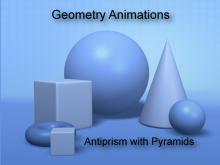
|
VIDEO: 3D Geometry Animation: Antiprisms 2 | VIDEO: 3D Geometry Animation: Antiprism Folding Out into Two Pyramids
This is part of a series of video animations of three-dimensional figures. These animations show different views of these figures: top, side, and bottom. Many of these figures are a standard part of the geometry curriculum and being able to recognize them is important. — CLICK THE PREVIEW BUTTON TO SEE THE VIDEO ANIMATION —Study these animations to learn the basic properties of these 3D figures. In particular, make a note of their sides, edges, and vertices. Look for any symmetries they have. Look for polygon shapes that are familiar. Finally, think of real-world examples that use these figures. Below we also include information about Platonic solids and 2D nets of these 3D figures. To get a better understanding of these 3D figures, study these basic forms. |
3-Dimensional Figures |
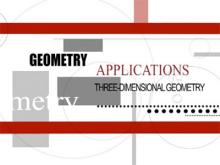
|
VIDEO: Geometry Applications: 3D Geometry | VIDEO: Geometry Applications: 3D Geometry
Topic3D Geometry |
3-Dimensional Figures and Applications of 3D Geometry |

|
VIDEO: Geometry Applications: 3D Geometry, 1 | VIDEO: Geometry Applications: 3D Geometry, 1
Topic3D Geometry DescriptionThis segment introduces Platonic solids, including tetrahedron, cube, and dodecahedron, emphasizing their congruent edges, vertices, and angles. It connects these geometric figures to both natural and man-made structures, setting the stage for exploring 3D geometry applications. This video offers a comprehensive look at the mathematical concepts behind 3D Geometry. Students will gain insights into practical applications and theoretical understanding of the topic, enhancing their ability to visualize and apply these concepts. |
3-Dimensional Figures and Applications of 3D Geometry |
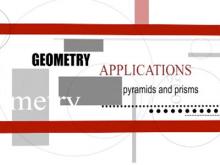
|
VIDEO: Geometry Applications: 3D Geometry, 2 | VIDEO: Geometry Applications: 3D Geometry, 2
Topic3D Geometry DescriptionThis segment explores pyramids, particularly Mayan and Egyptian structures, to distinguish rectangular and square bases. It discusses the volume of truncated pyramids using proportional relationships and introduces the concept of tiered volume reduction through geometric sequences. This video offers a comprehensive look at the mathematical concepts behind 3D Geometry. Students will gain insights into practical applications and theoretical understanding of the topic, enhancing their ability to visualize and apply these concepts. |
3-Dimensional Figures, Pyramids and Applications of 3D Geometry |
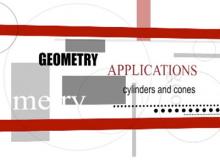
|
VIDEO: Geometry Applications: 3D Geometry, 3 | VIDEO: Geometry Applications: 3D Geometry, 3
Topic3D Geometry DescriptionThis segment examines cylinders, using the Shanghai Tower as a case study. It highlights how adjustments to height and radius affect volume and surface area, demonstrating these principles with geometric calculations and their architectural applications in energy efficiency. This video offers a comprehensive look at the mathematical concepts behind 3D Geometry. Students will gain insights into practical applications and theoretical understanding of the topic, enhancing their ability to visualize and apply these concepts. |
3-Dimensional Figures, Cylinders and Applications of 3D Geometry |

|
Worksheet: Crossword Puzzle--Circles | Worksheet: Crossword Puzzle--Circles
This is part of a collection of math worksheets that are crossword puzzles of math vocabulary. To see the complete worksheet collection on this topic, click on this link. Note: The download is a PDF file.Related ResourcesTo see additional resources on this topic, click on the Related Resources tab.Worksheet LibraryTo see the complete collection of Worksheets, click on this link. |
Definition of a Circle |